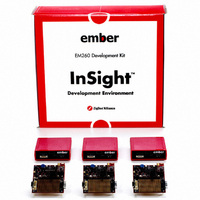EM260-DEV Ember, EM260-DEV Datasheet - Page 41

EM260-DEV
Manufacturer Part Number
EM260-DEV
Description
KIT DEV FOR EM260
Manufacturer
Ember
Series
InSightr
Type
802.15.4/Zigbeer
Specifications of EM260-DEV
Frequency
2.4GHz
For Use With/related Products
EM260
Lead Free Status / RoHS Status
Contains lead / RoHS non-compliant
Other names
636-1005
- Current page: 41 of 94
- Download datasheet (738Kb)
6.3.2
Structure
EmberNetworkParameters
EmberApsFrame
EmberBindingTableEntry
6.3.3
boolean
FALSE
TRUE
Structure Definitions
Named Values
Field
int16u panId
int8s radioTxPower
int8u radioChannel
int16u profileId
int8u clusterId
int8u sourceEndpoint
int8u destinationEndpoint
EmberUnicastOption options
EmberBindingType type
int8u local
int8u remote
int8u clusterId
EmberEUI64 identifier
0x00
0x01
Description
Network parameters.
The network's PAN identifier.
A power setting, in dBm.
A radio channel.
ZigBee APS frame parameters.
The application profile ID that describes the
format of the message.
The cluster ID for this message.
The source endpoint.
The destination endpoint.
A bitmask of options.
An entry in the binding table.
The type of binding.
The endpoint on the local node.
The endpoint on the remote node (specified by
identifier).
A cluster ID that matches one from the local
endpoint's simple descriptor. This cluster ID is set
by the provisioning application to indicate which
part an endpoint's functionality is bound to this
particular remote node and is used to distinguish
between unicast and multicast bindings.
A binding can be used to send messages with any
cluster ID, not just the one listed in the binding.
A 64-bit identifier. This is either the destination
EUI64 (for unicasts) or the 64-bit group address
(for multicasts).
An alias for zero, used for clarity.
An alias for one, used for clarity.
120-1003-000D
EM260
41
Related parts for EM260-DEV
Image
Part Number
Description
Manufacturer
Datasheet
Request
R

Part Number:
Description:
IC ZIGBEE SYSTEM-ON-CHIP 40-QFN
Manufacturer:
Ember
Datasheet:

Part Number:
Description:
EM260 RCM BOARD
Manufacturer:
Ember
Datasheet:

Part Number:
Description:
EM260 BREAKOUT BOARD
Manufacturer:
Ember
Datasheet:

Part Number:
Description:
KIT JUMP START FOR EM260
Manufacturer:
Ember
Datasheet:

Part Number:
Description:
IC ZIGBEE SYSTEM-ON-CHIP 40-QFN
Manufacturer:
Ember
Datasheet:

Part Number:
Description:
KIT DEV EMBER ZIGBEE W/PCWH
Manufacturer:
Custom Computer Services Inc (CCS)

Part Number:
Description:
PROGRAMMER USB FLASH EM250/260
Manufacturer:
Ember
Datasheet:

Part Number:
Description:
IC ZIGBEE SYSTEM-ON-CHIP 48-QFN
Manufacturer:
Ember
Datasheet:

Part Number:
Description:
IC RF TXRX ZIGBEE 128KB 48QFN
Manufacturer:
Ember
Datasheet:

Part Number:
Description:
IC RF TXRX ZIGBEE 192KB 48QFN
Manufacturer:
Ember
Datasheet:

Part Number:
Description:
INSIGHT ADAPTER FOR EM2XX
Manufacturer:
Ember
Datasheet:

Part Number:
Description:
IAR EWARM LICENCE FOR EM35X
Manufacturer:
Ember
Datasheet:

Part Number:
Description:
KIT EVAL EM250 RF TEST
Manufacturer:
Ember
Datasheet:

Part Number:
Description:
INSIGHT ADAPTER 3 FOR EM35X
Manufacturer:
Ember
Datasheet:

Part Number:
Description:
EM250 RCM BOARD
Manufacturer:
Ember
Datasheet:










